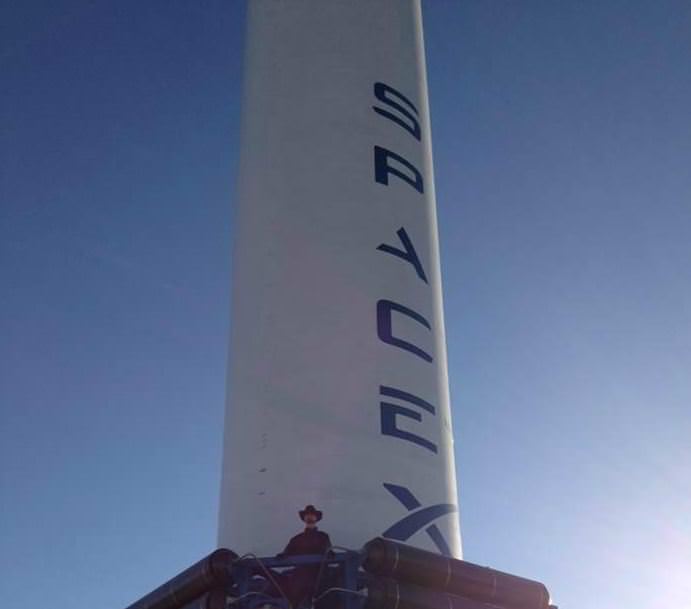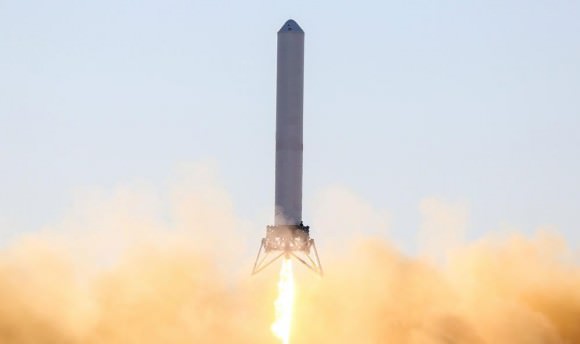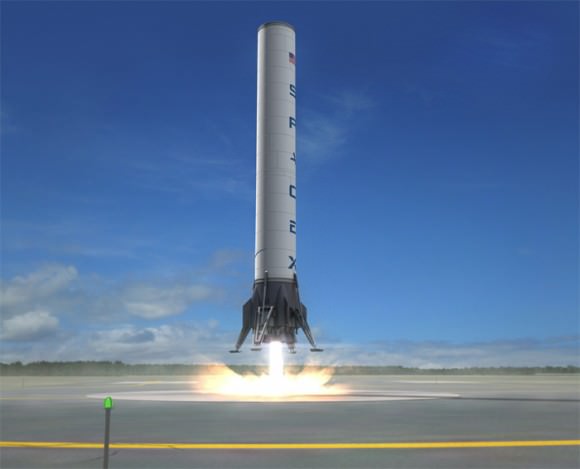SpaceX recently released video of the latest test of their Grasshopper Vertical Take Off and Landing Vehicle, where it rose 40 meters (131 feet), hovered and landed safely on the pad using closed loop thrust vector and throttle control.
The test flight took place on December 17, 2012 at SpaceX’s rocket development facility in McGregor, Texas. The goal of Grasshopper is to eventually create a reusable first stage for SpaceX’s Falcon 9 rocket, which would be able to land safely instead of falling back into the ocean and not being usable again.
SpaceX CEO Elon Musk Tweeted that they strapped a 6-ft (2 meter) cowboy dummy to the side of the rocket “to provide a little perspective on the size of Grasshopper.”
See the pictures below:
SpaceX said the total test duration was 29 seconds. Grasshopper stands 10 stories tall and consists of a Falcon 9 rocket first stage, Merlin 1D engine, four steel landing legs with hydraulic dampers, and a steel support structure.
Cowboy dummy riding on the SpaceX Grasshopper. Via Elon Musk
“Cowboy riding the rocket no problemo,” Tweeted Elon Musk
Artist’s rendering of the SpaceX Grasshopper’s vertical landing. Credit: SpaceX




This is all hot air. It’s one thing to land from a hover (we’ve been doing it for decades). It’s something else to retard a rocket in freefall from space, not to mention how you get it up there with sufficient fuel left on board. Also if you used parachutes to slow you down and with no in-flight controls you would need an impossibly large landing pad to cover the possible variables in reaching the ground.
It’s about time private companies got involved in space due to governments cutting NASA, ESA budgets. Maybe in a 10-20 years it will be cheap enough for the general public to go in to space for the price of a regular international flight.
I LIKE Space-X’s incremental approach with this solution… Inch by inch, step by step, closer and closer! GO Space-X! (Too bad they dint use a ‘Santa’ dummy?)
It REALLY is more difficult than it looks.
Armadillo really pioneered VTOL in the last few years with their Lunar Lander development but as Carmack said they really struggled with getting the flght software and hardware running at 100% .
To have such successful results so soon means the SpaceX engineers and esp. flight sotware guys are real pros . In Rocket science even the slightest software/hardware glitch will lead to “explosive” results.
To be frank, I think the calibre and quality of SpaceX engineers is likely quite higher than for Armadillo and other smaller players. SpaceX has netted COTS, CCDev, and now military launch contracts.
But since you mention Lunar Lander, I think it would be interesting to see if a Falcon9 stage could vertically land on the Moon. That might require some refueling while in Earth-orbit, but following that it could probably be quite doable.
I think the idea is for Mars, but I see no reason why it would not work on the moon. The only issue is that the moon’s engines should be LH/LOX, while Mars will likely be CH4/LOX.
Sure, but it’s Musk’s new MCT concept that’s going to be methane, while Falcon is RP-1.
Raptor was the tentative idea for an LH2 upper stage, and I suppose that could be the best candidate to adapt for a lunar lander. However, Raptor seems to have been shelved. Maybe it will be revived if Musk decides to go for the GTO market, or a possible lunar market.
Raptor hasn’t been shelved, it’s been reworked as a family of staged combustion methane based engines. More complex than the Merlins, but more efficient as well. Plus you don’t have to keep RP-1 sitting around:).
Actually, Armadillo did not pioneer this. NASA has had many science missions that have landed on the moon via automation.
What Armadillo has pioneered, is being the first private company to do it.
I’m really curious about what could be the source of hissing sound after landing. It also occurs before take-off.
They have LOX tanks and to keep them cool and low-pressure you need to vent the oxygen. I assume that is some of the noise around a pressurized cryogenic stage.
From what I understand there is usually a helium reserve to purge the lines of fuel (for cut off) or air (pre ignition). I’m not sure that is the case for SpaceX engines, but I haven’t heard anything to say they don’t use such a system.
The photo above of the dummy cowboy also shows what appears to be externally mounted gas cylinders. These could be the He, CO2, N2 or other gas suppression system we hear after main engine cut-off.
Pretty amazing. I think it was Looney Tunes that pioneered the concept in the 30’s.
It’ll be tricky, but the math all works out. Now it’s just a matter of doing it. People keep mentioning fuel, but that’s kinda sorta the VERY FIRST THING they considered before going forward with development.
I’m impressed. A rocket that is a VTOL. Sensor logic is stupendous. But, can it play the violin on the Moon or Mars coming from a standard entry like the LEM did on the Moon.
VTOL refers only to aircraft. Rockets are VTVL.
I have no idea why that is the case, but it is. Confused the heck out of me for a while there.
Vertical Take Off and Landing … Vertical T? Vertical Landing …beats the hell out of me too. Perhaps just to be snobbish and differentiate between a rocket and a fixed wing jet. LOL
Well Bert: This technology is still in the development stage, and there is a learning curve. I am sure that there were nay-sayers using versions of your argument right after the Wright Brothers first flight. And look at where we are now!
Anybody remember the DC-X? I think it made it to 10,000 feet and would have made a perfect landing if one of the landing gear legs had not collapsed. Oh well.
I was just viewing the DCX summary that youtube forked onto the video end. It was *very* maneuverable despite being “a flying tank”. They claimed 1000 feet height, but that was far enough for its acrobatics.
IIRC they did several landings before the failure, and the reason they mothballed the “Venture Star” program was the leakage of the composite hydrogen tank. Today they know more about composites and may be able to resurrect the program at will. Everything else worked including the necessary maximum-efficiency-at-all-altitudes linear spike engines.
The problem now is that nobody except SpaceX is shooting for a reusable launcher (or Shuttle replacement).
DCX wasn’t part of the VentureStar program. DCX was a military program that was cancelled, then transferred to NASA in an effort to save it at a minimal funding level. NASA’s engineers and management were invested in “airplane style landings”, and they thought that the VTVL style used by the DCX was impractical. So they cancelled funding on the DCX in favour of VentureStar.
Unfortunately VentureStar itself was deemed to be impractical with the technology of the time, so it was cancelled until such time as the necessary bits and pieces of prerequisite tech were developed (especially a lightweight, extremely strong composite hydrogen fuel tank… which is now possible, but wasn’t then).
In reality it turned out to be a permanent cancellation.
Thanks, maybe it wasn’t part programatically, but the history and the technology is entangled as you describe it.
Exactly gopher, DCX was a done on the cheap successful DARPA program that NASA took over and augered in. It did not fit their beloved Venture Star VTHL concept. Even today the venture Star SSTO is likely unachievable as the margins continue to be very low for SSTO regardless in possible improvements in tank fabrication.
? DCX was a “Prototype SSTO vehicle”, so what SSTO penalties goes for Venture Star goes for it too. [ http://en.wikipedia.org/wiki/McDonnell_Douglas_DC-X ]
Yeah. Because fuel cost is such a small portion of the cost of a launch, the margin isn’t that important (as long as it’s not ridiculously small).
I’m going to go on a loooong ramble here:).
The main benefits of a reusable SSTO vehicle are:
1) Reliability: When building any vehicle a certain percentage of them are going to be lemons (with consumer electronics they try to keep it below 3 percent. With manned rockets, they try for below 2% (Columbia class shuttles) or better (Soyuz). Because you’re starting fresh with each disposable rocket you build, you always have a 1+ percent chance of a serious issue (usually a bit more, sometimes a bit less, depending on who builds them). That’s scary. If airplanes worked like that we wouldn’t fly. Airplanes are safer for many reasons, but one of them is because we don’t build a new plane (and potential lemon) for each and every flight. They get tested and retested before passengers ever set foot in them. That’s what needs to happen with rockets.
2) Reusability: Musk says that with the Falcon 9 only 2% of the total launch cost is fuel. The fuel/cost ratio is supposedly even lower on ULA rockets. In other words, you spend 50 million building a giant rocket, then blow only a few hundred thousand on fuel to launch it. If you can reuse that rocket even a few times with only minor refurbishment, you’ve decreased launch costs by several times. Once you hit 12 or 15 reuses, you’ve decreased launch costs by an entire order of magnitude, even factoring in fuel consumption, pad maintenance, and refurbishment. We’re not yet at that point, but I think we ALL hope we will be as soon as possible.
3) The above apply to any reusable rocket, but SSTO rockets have an additional advantage: simplicity. Stage separations are an inherently dangerous event. Each separation you can eliminate decreases the danger of a launch. First start with the obvious ones: get rid of the “tow-er tower” launch escape system (they have to be dumped halfway to orbit). Second get rid of solid state boosters. They’re dangerous and nasty to begin with, so they’re an prime target. Then decrease the number of stages to a minimum (which is 2 right now). After that you’re in a pinch. The only separation event that is left is your 1st/2nd stage separation. You can’t get rid of that until you switch to Single Stage to Orbit design, which is a big challenge.
Ramble over:).
Yes. In fact with the lighter but higher performance Merlin1D engine the Falcon v1.1 first stage will also be SSTO.
Bob Clark
Hi Bert,
Regarding ….“not to mention how you get it up there with sufficient fuel left on board”.
The vertical landing knowledge gained from the Grasshopper test flights will be applied to the Falcon 9 v1.1 rather than the soon-to-be retired Falcon 9 v1.0 flown thus far.
As you might note from this comparison, the Falcon 9 v 1.1 (second from the right) has greater fuel capacity.
The speculation is that the V1.1’s greater capacity is intended for three reasons:
1) First and foremost for stage compatibility with the Falcon Heavy, which needed larger first stages (only having to manufacture one first stage was why the Falcon 1e and the Falcon Air were cancelled. It’s way cheaper to have just one manufacturing and assembly line),
2) To allow for greater payload, allowing SpaceX to eat into ULA’s EELV military contracts, and finally,
3) Giving SpaceX the future option (if it becomes practical) to making the Falcon 9 first stage reusable with a 20 to 30 percent reduction in payload, while still having enough mass-to-LEO to launch a manned Dragon to the ISS.
So even if the reusability of the Falcon 9 never materializes, the v1.1 was still a good move:).
Great post Gopher 🙂
SpaceX should be congratulated on recently landing it’s first two Air Force contracts – one of which was for the Falcon Heavy.
The out-going CEO at Lockheed-Martin is spitting the dummy over the prospect. Kinda serves ULA right for not better managing cost growth in the Atlas and Delta programs.
A reusable craft is only reusable if it doesn’t crash. This concept is silly. It uses rocket engines and fuel to do what our atmosphere can do better. Stick some wings and proper landing gear on it and you’re starting to think more clearly. Sorry but this is silly.
Why is it silly? Flying at 20.000 meters is not the same as going into orbit.
“…unless it’s being built to land on the moon or Mars. Why do I get the feeling it’s not…?” The applicability could be endless for this, even if the purpose right now might not be landing on the Moon or Mars.
The goal is full reuse with rapid turnaround, so there is a requirement to recover the 2nd stage as well as the 1st. Your suggestion would mean adding wings, a tail and landing gear to each stage. Each wing would require a thermal protection system such as heat tiles, a hydraulic system to operate the control surfaces and an associated power source.
The additional mass is highly problematic compared to simple landing legs and a fuel reserve.
They are using the atmosphere. I’s called a parachute.